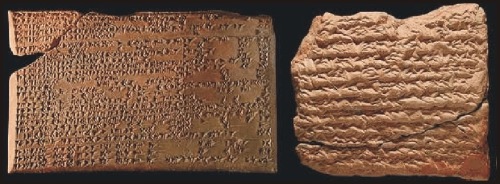Dalley: Apkallu, IDD 2011
by Estéban Trujillo de Gutiérrez
Iconography of Deities and Demons (IDD).
Apkallu.
“Mesopotamian semi-divine figure. A Babylonian tradition related by Berossos in the 3rd cent. (BURSTEIN 1978: 13f) describes a creature called Oannes that rose up out of the Red Sea in the first year of man’s history. His entire body was that of a fish, but he had another head, presumably human, and feet like a man as well as a fish tail.

Apkallus type 1 and 2, Stephanie Dalley, IDD.
Two forms of Apkallu are depicted here, the umu-apkallu or ummanu on the left, holding what appears to be a branch with poppy bulbs, and the puradu-fish type with banduddu bucket in left hand.
The sacred tree appears at center, beneath a winged device whose meaning is unclear to me.
The figure on the right is probably a king, as the rich garment is not topped by a horned tiara, indicative of divinity.
He taught men to write, as well as many other arts, crafts, and institutions of civilization. He taught them to build cities and temples, to have laws, to till the land, and to harvest crops. At sunset he returned to the sea. Later there were other similar creatures who appeared on the earth. These were the sages.
The sage Adapa, a priest of Eridu created by the god Ea/Enki, was also called Oannes. The name Oannes was thus connected, by true or false etymology, with the common noun for a sage in early Akkadian ummiānum, later ummânum.
The other Akkadian term for a sage, apkallu, can also mean a type of priest or exorcist. According to a Sumerian temple hymn, the seven sages came from Eridu, the first city in the Sumerian King List. Since Eridu was the city of Ea who lived in the Apsu, iconography involving water and fish is to be expected for the sages. According to late Assyrian and Babylonian texts, legendary kings were credited early on with having sages.

This water basin carved from a solid block of basalt was found in Nineveh near the temple of Ishtar. It is decorated with reliefs of apkallu – puradu-fish antediluvian sages.
(Pergamon Museum, Berlin)
http://www.arcalog.com/image-library/museums/assyria/sennacherib/
The Epic of Erra and Ishum (probably 8th cent.) attributes to Marduk the banishing of the sages down to the Apsu, and not allowing them to return. He describes them as pure purādu-fish, perhaps carp, who like their master Ea are especially clever, and were put among mortals before their banishment.
The ritual text bīt mēseri, for encircling a house with protective magical figurines, gives names to the sages of some famous kings in various cities (REINER 1961; BORGER 1974; see also HUNGER 1983: nos. 8- 11). Some of those sages angered the gods.

Bird Apkallū and Fish Apkallū, the so-called parādu-fish, side by side. Apkallū statuettes of this design were buried in appropriate places in the home of a Babylonian exorcist. They were believed to have apotropaic qualities, guarding the home from evil.
Ziusudra, also known as Utnapishtim and Atrahasis, was probably the last sage before the flood, the event which marks the division between immortal and mortal sages. Later sages were part mortal, part divine.
Kings credited with a sage include Enmerkar, Shulgi, Enlil-bani of Isin, Hammurabi, Nebuchadnezzar I, Sennacherib, and Esarhaddon, but this time span (legendary/Early Dynastic [26th cent.] to mid 7th cent.) does not match that of the identified iconography.
Certain texts are attributed to sages, notably two medical texts and a hymn (REINER 1961), the Myth of Etana, the Sumerian Tale of Three Ox-drivers, the Babylonian Theodicy, and the astrological series UD.SAR Anum Enlila.

Enuma Anu Enlil is a series of about 70 tablets dealing with Babylonian astrology. These accounts were found in the early 19th century by excavation in Nineveh, near present day Bagdad. The bulk of the work is a substantial collection of omens, estimated to number between 6500 and 7000, which interpret a wide variety of celestial and atmospheric phenomena in terms relevant to the king and state. The tablets presumably date back to about 650 BC, but several of the omens may be as old as 1646 BC. Many of the reports found on the tablets represent ‘astrometeorological’ forecasts (Rasmussen 2010).
http://www.climate4you.com/ClimateAndHistory%205000-0%20BC.htm
In Assyrian tradition the sages guarded the Tablet of Destinies for the god Nabu, patron of scribes. This information gives a possible link with the composite monsters in the tradition of the Babylonian Epic of Creation, which centers on control of the Tablet of Destinies.

Apkallu type 2. Stephanie Dalley, IDD.
A puradu-fish apkallu appears to the left of the sacred tree, with two fish-men, apparently a merman and a mermaid, on the right.
Wiggermann identified these composite beings as kullilu.
Such a link would explain the scene that puts phenotype 1 (see § II.1) with composite monsters who fight as archers (24), and phenotype 2 (see § II.2) with mermen (44*, 51) and composite monsters (50*). However, in known versions of the Epic, the hero-god, not the composite monsters, is called a sage; thus the relationship is not clear.”

Wiggermann and Green call this composite being “Scorpion-tailed bird-man.” He has a human upper torso, an avian body, and a scorpion tail.
In this drawing from Dalley’s article on the Apkallu, puradu-fish apkallu can be seen beneath them (Dalley, figure 50).
Anthony Green, “Mischwesen. B,” Reallexikon der Assyriologie (RLA), 1994, pp. 254-5. figure 15.
Stephanie Dalley, “Apkallu,” Iconography of Deities and Demons in the Ancient Near East (IDD), Swiss National Science Foundation, University of Zurich, 2011 (text updated 2011 and illustrations updated 2007), p. 1/7.

[…] examination of all the extant, provenanced depictions of composite beings, Mischwesen, in Neo-Babylonian (NB) iconography sheds important new light on the worldview of the last great […]
LikeLike